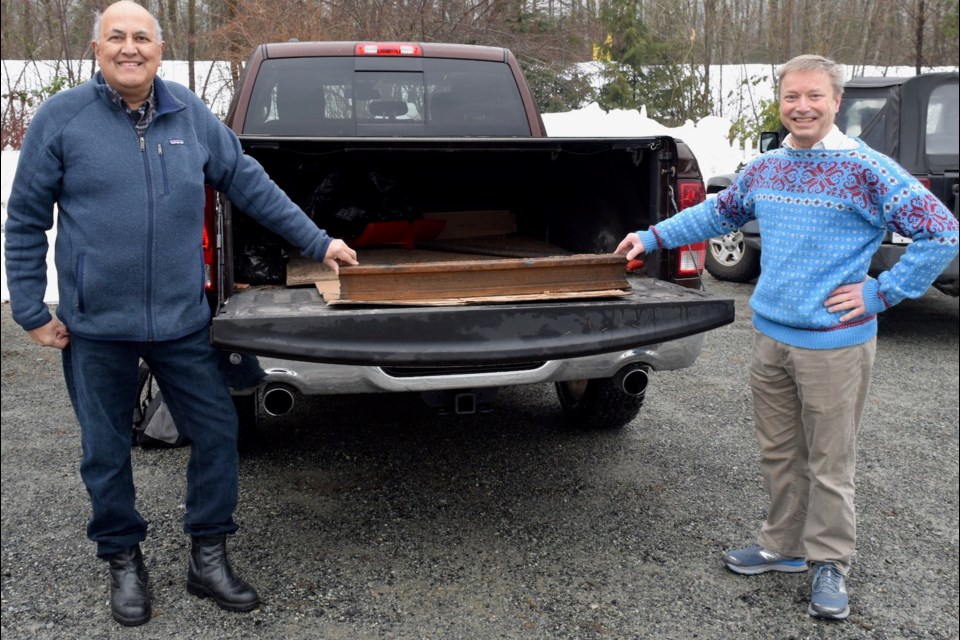Some pieces of Squamish's rich rail and logging history were recently dug up — literally.
It all started when Squamish Coun. Eric Andersen, who spoke to The Squamish Chief in his role as a local historian and member of the Sea To Sky Forestry Centre Society, alerted municipal engineers to the possibility of historic rail lines in an area of a sewer replacement project.
Sure enough, in November, District crews discovered exposed railway tracks 60 to 90 centimetres (two to three feet) below the surface of Mamquam Road, between Government Road and Highway 99.
This was the former site of a junction between the north-south Howe Sound & Northern Railway — later Pacific Great Eastern — mainline and the Newport Timber Company logging railway, according to Andersen, who penned the story of the discovery and history of the company in "The Newport Timber Company — exposed."
After the discovery, the District's engineering department alerted the Railway Museum of British Columbia (formerly the West Coast Heritage Railway Park) and the Sea to Sky Forestry Centre Society about what they had found.
The uncovered pieces — which are stamped “Algoma Steel 60lbs 1910” — are welcome additions to the rail museum.
"Basically, we're going to sandblast that, paint it up, highlight the lettering, put it on something, maybe a board for display along with the story," said Jaswant Singh Biln, who is on the board of directors of the museum, as he looked over one of the pieces in the back of his pickup truck.
Bolted rail like this came from the foundry in 12-metre (39-foot) sections, but the old rail broke up when dug up, ending in about 10 pieces of rail approximately one to three metres each, Biln said.
The five diagonal marks on the rail mean it was made in May, Biln explained.
The rail's maker and batch number are also stamped on it.
"So you could trace this steel right back to when it was made. And that was very important back then, because if there were any defects that caused derailments or broken rails and stuff, they needed to trace back," he added.
The piece is curved because the rail line was making a bend or turn.
"It was making a bend, and that was called Mamquam Crossing. So, it made a bend to head down to the water," said Andersen.
Newport Timber, which operated from 1910 to 1913, was the first railway logging operation to set up in the Squamish Valley, according to Andersen.
Among the approximately 150 workers for Newport Timber, only a few — who were Sḵwx̱wú7mesh (Squamish First Nation) — already lived here. The rest came from far and wide — the Maritimes, the U.S. Midwest and Norway.
Some stayed.
"There's now five or six generations of people here in Squamish who worked for Newport Timber," Andersen said.
"From 1910 when the Howe Sound & Northern railway line to Cheekye was completed until the arrival of a huge workforce of over a thousand men to build the PGE line northward up the Cheakamus valley in 1912 to 13, the Newport Timber Company was the largest local employer," Andersen writes in his report.
The Newport line also represents the start of the Squamish we know today, he said.
"The story of the Newport Timber Company really is the beginning of everything... Look at all the treasures here that the railway is going to open up — farmland, timber, copper, gold. And so the Newport name is really the very beginning of any kind of town or anything happening here... The only industry at this time was hops."
Today, where the Newport Timber Company was logging, we've now got second-growth 100-year-old trees, he added.
"It's either in the Squamish Community Forest or the Squamish Nation lands they got through the Olympics," he said.
Other legacies of the company include roads and trails — Loggers Lane, Mamquam Road, and the Ring Creek Forest Service Road, among others.
For the public to see and learn from
The museum will officially take this artifact pieces as part of its collection.
It will be cleaned up and on display, likely in the museum's Roundhouse at the park this spring, he said.
In addition to being put on display, one idea is to cut up some of the polished rails and perhaps offer them to history buffs who are interested.
"Make a little certificate or a plaque that says Newport Timber Company rail from 1910 and give out as souvenirs or sell or whatever because it is a piece of Squamish history," Biln said. "That's what we're all about — to tell the railway history story."
The Newport company came to an end after a devastating 1913 fire.
Eventually, the operational rail line shifted away from the junction and the discontinued line was later covered with road.
The area was too prone to flooding, Andersen explained.
Andersen and Biln said there still are likely plenty of other rail and logging artifacts to be dug up or discovered around town.
"We must give the District crews credit," Andersen said of this rail line discovery. "It was very nice of them to think of us both: our group — the Forestry Centre and the railway museum. And that's great," he said. "And I told them that there are the remains of a log flume up by the landfill and so they should keep an eye out for that too."
Learn more about the Railway Museum of British Columbia, which is run by the non-profit West Coast Railway Association here.
Learn more about the Squamish Forestry Centre Society here.
Read more of the history in Andersen's write-up below:



